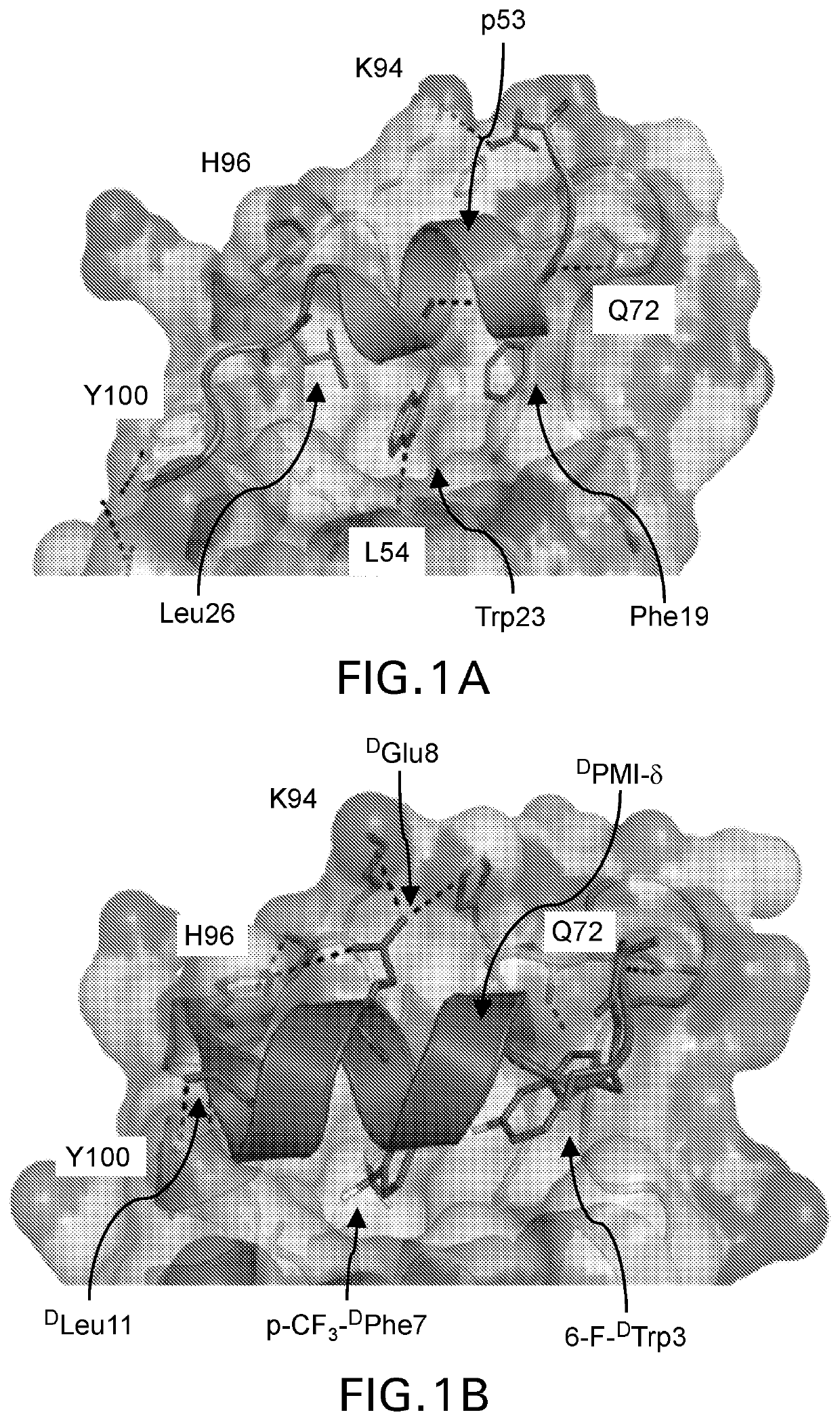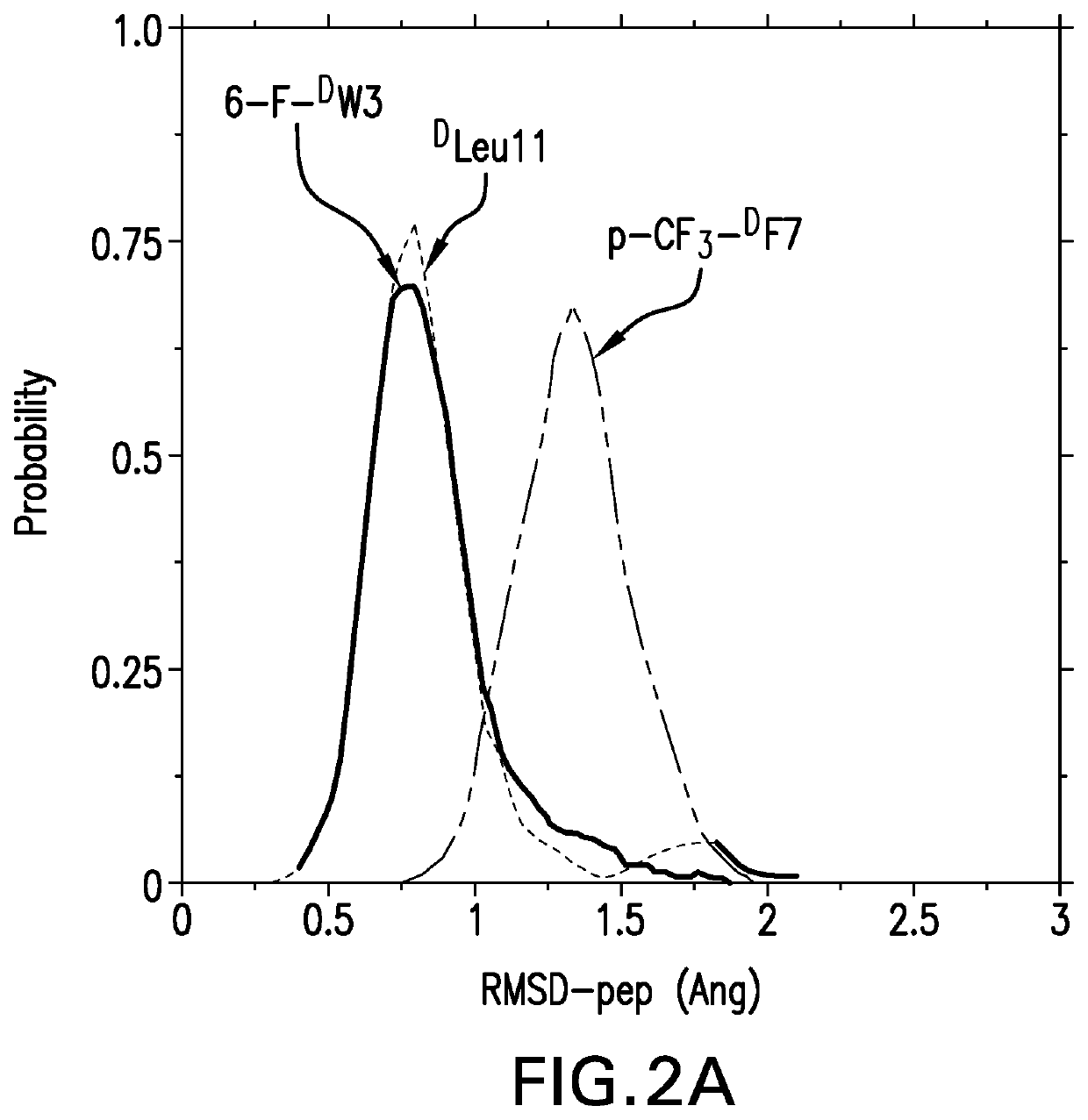P53 activator peptidomimetic macrocycles
a peptidomimetic and macrocycle technology, applied in the field of peptidomimetic macrocycles, can solve the problems of peptide modality difficulty, failure to successfully develop small molecule inhibitors, and toxicities that cannot be met with dose limitation
- Summary
- Abstract
- Description
- Claims
- Application Information
AI Technical Summary
Benefits of technology
Problems solved by technology
Method used
Image
Examples
example 1
Conformational Landscape of DPMI-δ Peptide in Apo and MDM2-Bound States
[0144]We sought to rationally design stapled DPMI-δ analogues that would stabilize helical structure and preserve or enhance binding affinities. Accordingly, we applied molecular dynamics (MD) simulations to the published co-crystal structure of the MDM2-DPMI-δ complex to understand its structural details critical for the maintenance of the binding motif. During the simulation, the bound conformation of the DPMI-δ peptide remained stable with an RMSD of DPMI-δ peptide retained its crystallographic α-helical conformation throughout the simulation (>95% α-helicity). The peptide bound state of MDM2 also remained stable with an RMSD of DTrp3 and the backbone O of Gln72 [FIG. 1B], is preserved in ˜80% of the simulation. Other hydrogen bonds seen in the crystal structure and reflected in the simulations but for shorter durations included i) the side chains of Gln72(MDM2) and Thrl(DPMI-δ), ii) the side chains of Lys94 / ...
example 3
Peptide Stapling Increases Helicity
[0148]BP-REMD simulations suggested that all of the designed stapled DPMI-δ analogues should have increased solution-based helicity. Specifically, we predicted solution helicities between 24-39%; values that were increased compared to the predicted and measured values of ˜21% for the unstapled parent sequence (vida supra). The values for the stapled analogues aueed well with those obtained experimentally via CD spectroscopy (ranging from 24.5% to 38%)[FIG. 5A]. This increase in helicity upon stapling mirrors what has been reported for stapling all-L amino acid peptides [57-58].
example 4
Stability and Binding Affinity are Improved Upon Peptide Stapling
[0149]We next carried out MD simulations of the stapled DPMI-δ peptides bound to MDM2. Using the linear DPMI-δ peptide / MDM2 co-crystal structure as a starting point, staples were modelled into the all-D peptide at six sets of residues and subject to MD simulations. The stapled peptides remained stable during the MD simulations and remained largely (˜95%) helical. The three critical residues 6-F-DTrp3, p-CF3-DPhe and DLeu11 remained buried in the hydrophobic pocket / binding site of MDM2 [FIG. 6]. The hydrocarbon linkers remained largely exposed to solvent without engaging the MDM2 surface; this contrasts with some of the L-amino acid stapled peptides where the staples contributed to the binding by engaging with the surface of MDM2 [52-53].
[0150]Next, the ability of these peptides to bind MDM2 was measured using fluorescence polarization [FP], surface plasmon resonance (SPR), and isothermal titration calorimetry [ITC] exp...
PUM
| Property | Measurement | Unit |
|---|---|---|
| Effective dose | aaaaa | aaaaa |
Abstract
Description
Claims
Application Information
 Login to View More
Login to View More - R&D
- Intellectual Property
- Life Sciences
- Materials
- Tech Scout
- Unparalleled Data Quality
- Higher Quality Content
- 60% Fewer Hallucinations
Browse by: Latest US Patents, China's latest patents, Technical Efficacy Thesaurus, Application Domain, Technology Topic, Popular Technical Reports.
© 2025 PatSnap. All rights reserved.Legal|Privacy policy|Modern Slavery Act Transparency Statement|Sitemap|About US| Contact US: help@patsnap.com



